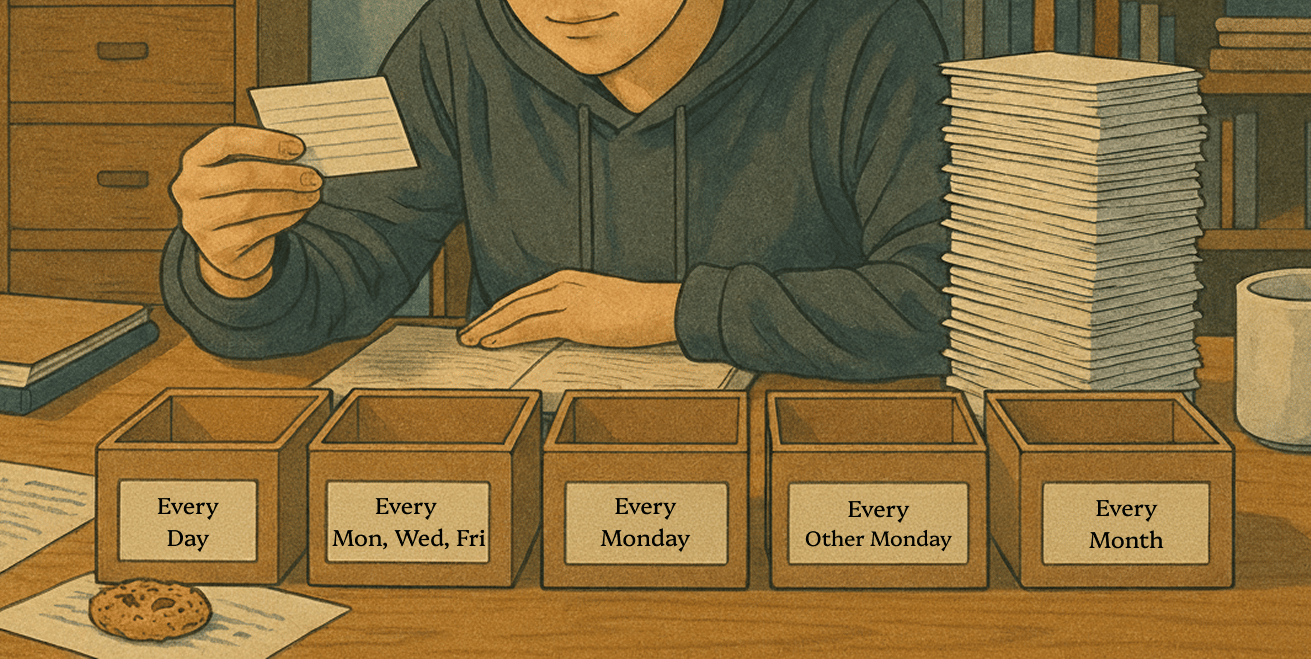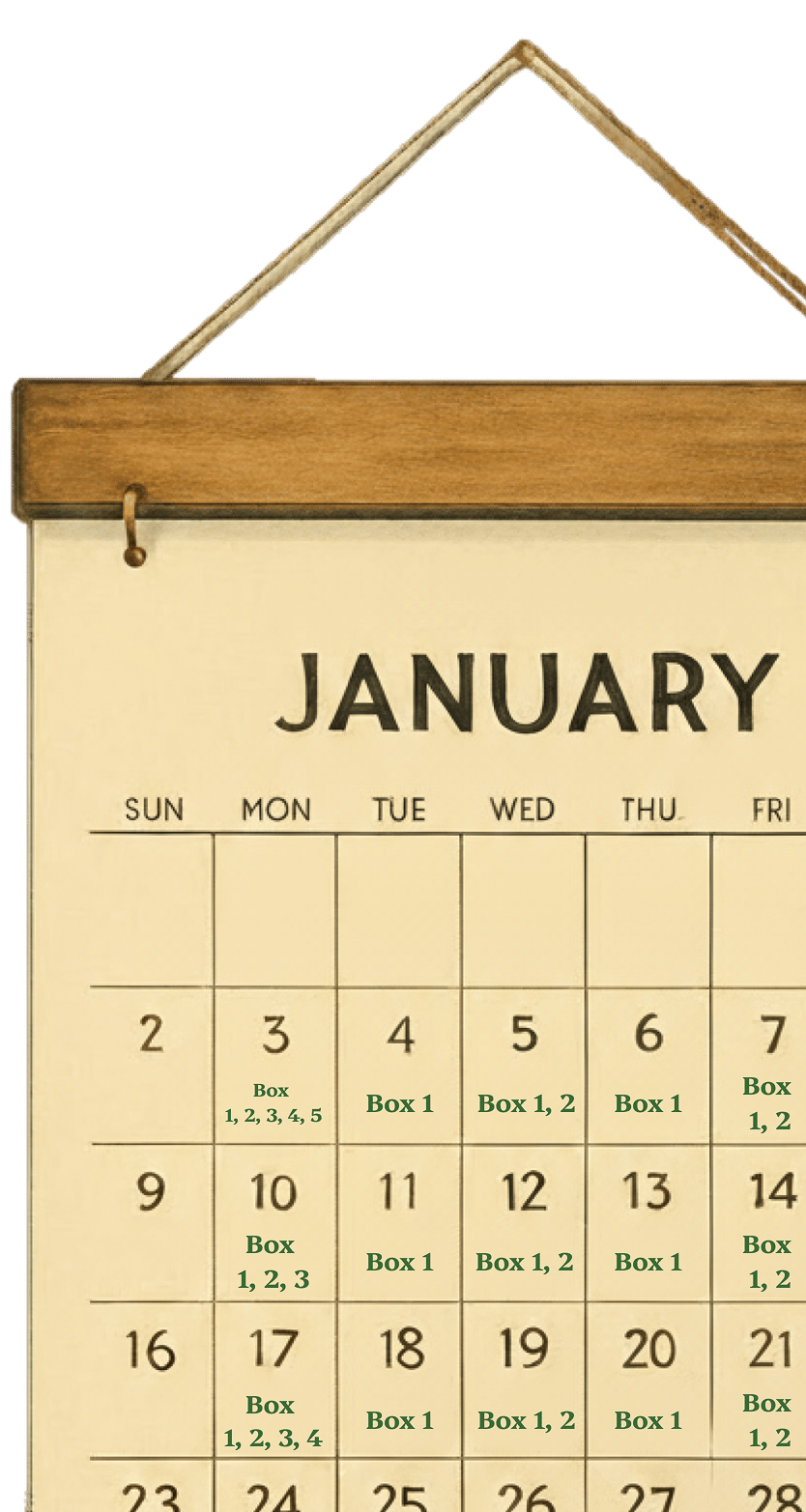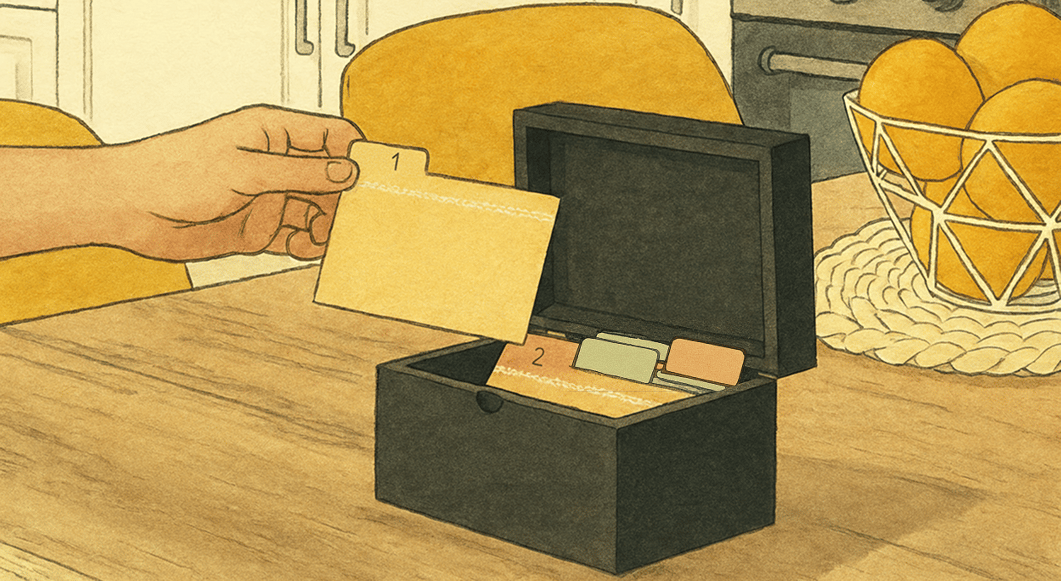- VitalCore Newsletter
- Posts
- The Leitner System: Card by Card, Memory for Life
The Leitner System: Card by Card, Memory for Life
How a simple method can turn flash cards into lasting knowledge
Are flash cards the most widely used study tools of all time? Everyone at some point has experimented with them. Late at night, on the bus, between classes. They’re simple, portable, and promise quick recall. The problem isn’t flash cards themselves; it’s forgetting to review at the right time. Without timing, facts fade just as fast as they were crammed.
The Leitner System fixes that by building timing into the process. Think of it as a simple conveyor belt for your memory: new and shaky ideas ride past often; solid knowledge drifts by less and less. You don’t need an app or a subscription. You need a small stack of index cards, five labeled piles, and the discipline to follow a schedule measured in days rather than hours. When you do, the same cards that once felt like trivia start to feel like anchors - reliable cues you can call up when a quiz, a patient, or a deadline demands them.

At its core, the system is a loop. You create a card with a prompt on the front and an answer on the back. All new cards begin in Box 1 (Every Day), the most frequently reviewed group. When you can recall a card quickly and cleanly, you promote it to the next box, buying yourself more time before you see it again. When you miss or hesitate long enough to be unsure, you send it back to Box 1 where it will show up again tomorrow. That promote-or-reset rule is the entire machine. The timing emerges from it: Box 1 shows up daily, Box 2 every other day, Box 3 roughly twice a week, and so on, until Box 5 cycles in a couple of times a month. This pacing lands review sessions in the sweet spot just before forgetting, which is precisely where practice strengthens memory the most.
If you’ve never worked this way, the first surprise is how manageable it feels. You don’t sit down to “study everything.” You sit down to review what is due today. That might be ten cards or fifty depending on yesterday’s performance, but there’s a finish line. When you reach it, you’re done for the day. That finish line, more than the boxes themselves, is what keeps people returning to the habit. It turns an open-ended chore into a bounded commitment. The brain respects promises it believes you can keep.
Setting up takes minutes. Label five piles 1 through 5 and pick simple intervals—daily for Box 1; then every 2, 4, 8, and 16 days for Boxes 2 through 5. Tape a sticky note to each pile with its next review date. Start with thirty cards so the system feels light. Your first sessions will be short because most cards sit in Box 1. That’s fine: you’re building the habit and the pipeline at the same time. As you promote cards, the work spreads out. What felt dense and repetitive on day one becomes smooth and oddly satisfying by day ten.
Card quality matters more than people think. The best cards ask for one clear thing. “Define photosynthesis” invites a paragraph and accepts a shrug; “What organelle performs photosynthesis in plants?” demands a crisp answer—chloroplast—and gives you an unambiguous check. When you need to test a sentence, use a fill-in-the-blank and hide only the critical word. When the topic is numerical, add units or constraints so your recall has edges. These little choices reduce fuzzy prompts and make it easier to judge yourself honestly, which is the only way the promote-or-reset rule works. A system that tolerates half-answers trains half-knowledge.
The Leitner System shines with material that benefits from retrieval on demand: terminology, formulas, vocabulary, labeled diagrams, short definitions, and canonical steps in a process. It’s not a full replacement for problem sets, labs, or essays—and it shouldn’t be. Use cards to store the atoms of knowledge, then combine those atoms in other contexts to learn structure and meaning. Many students find a pleasant rhythm here: morning reviews for the small truths; afternoon work for the big ideas. The spacing in the morning makes the afternoon flow faster.

The evidence behind the method is straightforward. Spacing reviews over days and weeks yields better long‑term retention than cramming the night before. Testing yourself—actually trying to recall before you look—strengthens memory more than re-reading. And making recall a little effortful (but not punishing) produces learning that lasts. The Leitner System operationalizes all three without jargon: it spaces, it tests, and it keeps the effort right at the edge of forgetting by adjusting intervals as you succeed or struggle.
Of course, simple does not mean effortless. The most common failure mode is card creep: writing bloated cards that try to cover a chapter in a sentence. Split them. Another trap is interval bravado: stretching the time between encounters too soon because it feels good to promote. Be conservative until you trust your internal sense of “I truly know this.” Finally, protect the daily checkpoint. You don’t need an hour—twenty focused minutes is enough—but you do need regularity. Consistency compacts the work; inconsistency compounds it. When you miss a day, resume with the smallest box numbers and work forward. Let the backlog dissolve across two sessions rather than trying to win it back with a marathon.
You can tailor the system to your context without breaking it. Younger learners often do well with three boxes and gentler spacing. Some people color-code by topic to keep variety in each session. Others like to interleave subjects—biology cards mixed with history—which can improve transfer because the brain must sort out which rules apply when. If you prefer your phone, apps like Anki model the same logic digitally. What matters is the principle, not the medium: frequent exposure when knowledge is fragile; infrequent exposure when it is sturdy; honesty always.
A realistic weekly cadence looks like this. On weekdays, you sit for fifteen to twenty-five minutes and clear what’s due. Twice a week, after you finish the due stack, you add a small handful of new cards—five or ten—so your pipeline grows steadily. On Saturday, if the load is light, you skim for cards that feel trivially easy and archive them; it’s motivating to see the pile shrink. On Sunday, you rest. Sleep is when consolidation happens; your future self will thank you for not trying to hack biology with bravado.

If you want a recipe to start this afternoon, here it is in words, not a checklist. Label five piles and choose the 1‑2‑4‑8‑16 day spacing. Write thirty atomic cards with clean prompts and answers. Today, review Box 1. When an answer arrives quickly and precisely, move the card up a box; when it doesn’t, put it back in Box 1 without guilt. Tomorrow, review what’s due. Only after you’ve cleared the due stack do you add a few new cards. Keep the sessions short enough that you finish them, and honest enough that you trust them. In two weeks, you’ll notice a calm you didn’t have before—a sense that the facts you need are actually there when you reach for them.
Flash cards aren’t the problem—timing is. The Leitner System gives you a repeatable way to review just before forgetting, turning a pile of paper into a durable knowledge engine. Start small, promote slowly, and stop when you hit the daily finish line. Next month’s memory will feel like it belongs to you, not to the last all‑nighter you survived.
